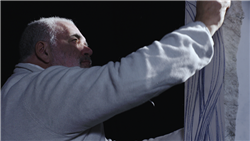
All facets of the art life are on display in Mercedes Sader’s telling documentary, “The Children Of The Mountain,” (“Los Hijos De La Montaña”), which digs intimately into the repertoire and psyche of renowned Uruguayan sculptor Pablo Atchugarry.
The film is set to bow Jan. 2 at this week’s ARCA International Festival of Films on Arts, opening the festival’s promising second edition, held at the protagonist’s recently inaugurated Contemporary Art Museum in Punta del Este.
A roving live-action memoir, the account achieves certain whimsy as it unravels the inner workings of the artist who forges materials from the wild, one emotive sculpture seemingly inspiring his next with demand for his work far outpacing supply.
The project is an Uruguayan-Italian co-production between Sebastian Bednarik and Andres Varela at Montevideo-based Coral Cine (“Benedetti, 60 Años de Luz”) and Sader, who also work in tandem to bring ARCA to life. Additional production credits go to Italy’s Format.
Ahead of the film’s screening, Sader spoke with Variety about its compelling narrative.
You include not only the luxurious side of being a recognized figure in the art world, but also the more mundane aspects of conceiving new works and sourcing materials. Can you speak to that a bit?
We thought we knew the work of Pablo Atchugarry, but we knew very little about his private life. As I entered his world, I discovered a vast and diverse body of work and found myself following the footsteps of Pablo and his family around the world, immersed in that somewhat nomadic life, between Italy and Uruguay, also the U. S.
From the initial idea, the film was changing and growing. The team’s been essential throughout this process. I’ve been carrying out projects withCoral Cine for many years and it’s been a great personal challenge when the producers Sebastián Bednarik and Andrés Varela entrusted me with the direction of this film. It was very interesting what happened during the pandemic. Together with Santiago Bednarik, editor, sound director and co-scriptwriter, we decided to take advantage of those first months, to watch all the shoots we’d done, we began to test possible montages.
I think it was a very loving process in which we were able to conceive a film, in which we had very clear priorities: Aesthetics and care for the image, how to show the works of art; keeping the idea of the journey alive, both metaphorically and in reality. It’s not a road movie but the journey and the movement is a constant that serves as a common thread in the film. This journey is also inside the protagonist, this man who works obsessively and who needs to create as much as he needs to eat. Another priority was music. Luciano Supervielle has done an incredible job, his music brings great emotion to scenes in the film.
How much of art is simply the stubborn persistence to express yourself and be heard?
Art is a way of understanding the world. Especially contemporary art, which is what captures the essence of our time. A work of art is not only the result of work and technique, but there is also some madness, passion, humor, fear, it’s an expression of the reality that surrounds us.
Artists arouse a deep curiosity in me: What’s their creative engine? How do they see the world? What are they trying to communicate to others? I’m interested in capturing those singularities in one of the richest ways of communicating that I know, which is cinema.
“Material dictates,”said the filmmaker Ferruccio Musitelli. For Atchugarry, the material is the block of marble containing the work in itself, the sculpture has always lived in the stone. His task is to remove what’s left over and bring into the world “The Children of the Mountain”. For Musitelli, filming was letting the subject speak for itself. There’s a photograph that Musitelli took of Pablo in 1979, in Italy. A young Pablo, with his long beard and hair, almost like a caveman, loading a heavy block in a baby carriage. From that stone his first marble sculpture was born.
Today, 44 years later, there’s a story, the life of Pablo Atchugarry, that deserves to be told and shared. My way to do it is the cinema, because, in the words of Andrei Tarkovski, “like no other form of art, it amplifies, enriches and concentrates the affective experience of man, increasing it and making it definitely longer.”
In your opinion, what’s the most fascinating aspect of Pablo’s life?
There’s no separation between the art that he creates and the life that Pablo Atchugarry leads. It’s been fascinating to enter his daily life and understand his creative process as part of life itself. There’s something quite magical that happens when you meet someone who lives seamlessly between their need to create and their day-to-day. You come to understand intimately that art connects, heals and that it shows you an exciting world view. I especially believe that Pablo is a great and tenacious dreamer and that his life is a wonderful example, especially for young artists.
Read More About:
Source: Read Full Article